#freshwater plesiosaur
Explore tagged Tumblr posts
Text
Fish of the Day
Today's fish of the day is the Freshwater Plesiosaur!
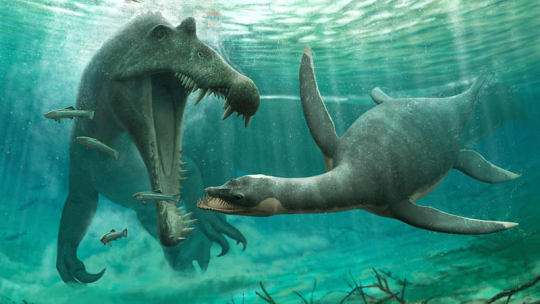
The freshwater plesiosaur was requested by Jasper, thank you Jasper! Plesiosaurus as a marine reptile, well known for their prowess as apex predators, but freshwater plesiosaurs are a relatively new idea. Based on the finding of a couple of fossils in what is now Morocco's Sahra desert river system, specifically an area called the Kem Kem beds. These fossils are scattered, showing us that this is not just the bones of one animal but a group of freshwater plesiosaurs that lived in the area, at least a dozen of them. The finding of many teeth in particular shows that these animals didn't just swim in from the ocean temporarily, but lived in the area long enough to shed teeth. This has led to some theories that the popular cryptid, The Loch Ness Monster, may be a freshwater plesiosaur, although no fossils have been yet found in that area. Although this does not confirm their existence it raises a strong argument for them. However, with limited knowledge about them for the time being, let's go over plesiosaurs in general!
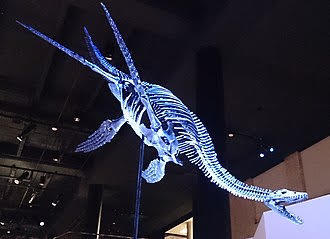
Found and named in the early 1800's the plesiosaur, from order Plesiosauria, is thought to have first appeared in the late Triassic Rhaetian stage, about 203 million years ago. These animals went extinct about 66 million years ago, to the Cretaceous-Paleocene extinction event. How they swam is still up for debate, many favor the theory that they had wide range with each of their fins, and had identical strokes, but other theories are that they may have used only the fore or hind fins for locomotion, or perhaps used them in reciprocal movement. Similar debate exists for how these animal may have dived, although we know they dived for food, as signs of decompression sickness have been found. As apex predators they ate through anything they could get close to, small fish, larger fish, sharks, cetaceans, crustaceans, one another. It is found that although they were certainly near the top of the food chain, some of them were still occasionally prey for large sharks, but mostly they fell to one another, larger plesiosauria hunting smaller. It is thought they evolved to fill the niche left open by the extinction of Ichthyosaurs, which died out in the late Cretaceous, and allowed for diversification to take place in Plesiosauria. Plesiosauria during this era evolved two distinct morphological types: the pliosauromorph build, the Pliosauroidea family, and the plesiosauromorph build, the Plesiosauroidea family.
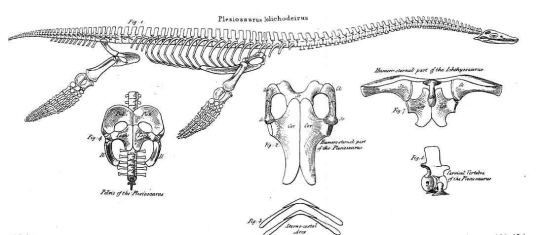
Pliosauroidea is defined by their large heads and short necks, often compared to the build that crocodiles have. They are also known for having larger hind flippers than other plesiosaurs and can be found mostly across South America, and along the equator, although some fossils have been found as far north as Norway. The largest genus found so far, the Liopleurodon, is as large as 6 feet 5 inches, or just a little under 2 meters.

Plesiosauroidea was defined by the long skinny neck, which was used to hunt in small holes, and could move fast to snap up small marine animals nearby them. Although Plesiosauroidae is often depicted as a fast moving predator, it is found that they were likely slow swimmers, pushing their way through the water similar to the swimming methods of turtles, staying close to the surface and using their four limbs for mobility, making it easy to snap at nearby animals. Despite the common displays of them in swan-like positions, with the head raising out of the water, this is unrealistic, as they could not raise their heads up to a degree like that, and the weight of the muscles would prevent them from surfacing. The size difference between differing species was huge, as some could be only as large as 3 meters to 20 meters in length. It is currently thought that the freshwater finds belong to Plesiosauridea.
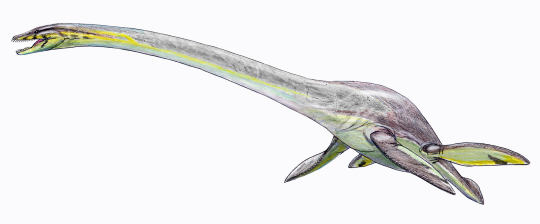
Everyone have a good day!
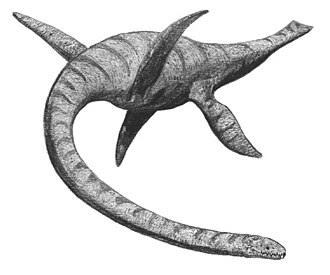
#fish#fishblr#fishes#fishposting#aquatic biology#aquatic#marine biology#ichthyology#marine animals#marine life#freshwater#freshwater fish#animal#animals#animal facts#fish of the day#information#education#nature#river#paleo#paleontology#plesiosaur#plesiosaurus#freshwater plesiosaur#Plesiosauria#Pliosauroidea#Plesiosauroidea
29 notes
·
View notes
Text
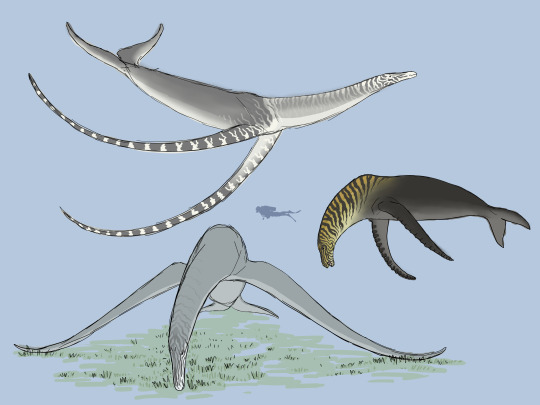
Some sketchy concept stuff that I'm posting because I liked it but couldn't be bothered to refine it into an actual artwork.
These submarine behemoths are the Mermares (Clade Euhippocampiformes), secondarily aquatic descendants of the domestic donkey. The group first appeared around 29 million years post-cataclysm, in the late Nerian stage of the Diluvian period. They evolved from an animal called the Seabra, a descendant of the Donkey which adapted to exploit a niche with, thus far, zero competition - that of a large marine herbivore.
On earth, marine ecosystems are notable for the distinct lack of vascular plant life, a condition caused by a number of factors - most notably the osmotic stress caused by the saltwater. Most photosynthesis is carried out by algae. On Spero, however, things are different. Because Spero's oceans were generated relatively recently, from extraterrestrial ice particles, there just hasn't been enough time for erosion and the water cycle to deposit dissolved minerals in the water. As a result, Spero's seas are made of freshwater - a much more tolerable condition for most plants, and thus the diversity of marine vascular plants is much, much higher than on earth. Also, due to the flatness of the flooded landscape and lack of any real tectonic features, enormous swathes of the seabed lie within the photic zone, less than 200 meters from the surface. Thus, endless expanses of marine grasslands - the "seagrass prairies" - extend from the shore, often for hundreds of miles before the water finally gets too deep for photosynthesis to occur.
All of this plant life is an extremely attractive prospect for herbivores, and it was likely what drew the ancestral Seabra to forage in shallow coastal meadows in the first place. But as the oceans got deeper and life adapted, the Seabra had to adapt in kind - their hind legs rotated backwards to act as a pair of propulsive flukes, their forelimbs developed into steering flippers, and their nostrils retreated to sit on their foreheads.
One notable feature of the Mermares is hyperphalangy, a condition where the fingers have too many bones. It's very common in large marine tetrapods in Earth's history - whales and dolphins, Ichthyosaurs, Plesiosaurs, and Mosasaurs all exhibited hypoerphalangy to some degree - and seems to be associated with the specialization of the limbs into flippers. We would expect to see similar patterns in marine lineages on Spero. What's unique about the Mermares, however, is the sheer number of extra phalanges in the finger; at least fifteen in the shorter-finned species, and more than thirty in the longest-finned forms. And because Mermares - being equids - only possess one digit per limb, the result is a single long chain of flat, squarish bones which, in some cases, can reach over forty feet long - the longest arms ever to exist.
These ridiculous appendages produce a lot of drag and are merely adequate for steering and stabilization. So why do the Mermares have them?
The answer is that they're weapons. And particularly devastating ones, at that.
Mermares use their flagellating flippers as bludgeons, against both predators and conspecifics. The flippers are connected to powerful neck muscles and can be swung forward with impressive force; combined with a well-timed twisting of the giant horse's torso, the huge flippers can impact hard enough to shatter bone and pulverize flesh. The flippers themselves do not escape unscathed, and older individuals often have scarred or mangled flipper-tips from numerous battles over the years; but it's a small price to pay for survival.
When not being used against their enemies, the flippers may be folded back against the sides of the animal to reduce drag, or used as props to keep the animal's belly up off the seabed when feeding. Mermares spend up to 18 hours per day grazing, using their long neck to crop aquatic grasses and other vegetation in a wide arc without moving their bodies and occasionally dipping up to the surface to breathe. Mermares are keystone species in the seagrass prairies; as hindgut fermenters, they are not as efficient at processing plant matter as ruminants like goats, and produce large amounts of nutrient-rich dung which acts as fertilizer for the meadows and helps keep the environment productive. The dung also acts as food for a variety of fish and invertebrates.
Let's look at some of the Mermare's diversity, shall we?
Drepanarion (center right) One of the smaller Mermares, Drepanarion nonetheless grows to nearly 12 meters (39 feet) long. It is immediately recognizable by the bold black-and-yellow striping on the heads and necks of the stallions, and by the tall, narrow nuchal crest which extends from the withers and makes the stocky body look even more powerful. Unlike most other Mermares, which live in small groups of less than ten individuals, Drepanarion can be found in herds of over a hundred in the seagrass prairies of the Savanian (41 - 50 million years post-cataclysm). These nomadic throngs graze patches of seagrass nearly to the roots before moving on, giving the ecosystem time to regrow before returning in a few years' time. Drepanarion exhibits the most extreme sexual dimorphism of any Mermare, with stallions being both larger and more brightly coloured than mares; during the annual rut, males will fight each other in brutal bludgeoning matches to establish dominance and secure mates. To this end, they have some of the most extreme flipper anatomy of any Mermare; though not especially long (indeed, they have the shortest flippers of any derived genera), each phalanx bone has a protruding bony tubercle on the anterior edge which extends into a keratinous knob. These knobs both protect the flipper during combat and focus the force of the blow into a smaller area, dealing more damage.
Hipposeidon (bottom left) First appearing in the early Imberian (50 million years post-cataclysm), Hipposeidon is the largest of all Mermares and, indeed, the largest animal ever to exist on Spero, with stallions regularly reaching over 24 meters (80 feet) long (mares are slightly smaller). Extremely large specimens may even reach 30 meters (100 feet), although this is rare. This ludicrous size - nearly rivaling even the mighty Blue Whale of Earth - is possible only due to the sheer abundance of its food. Hipposeidon appears at the height of the seagrass prairie's extent, and can pack away almost 900 kilograms (1900 pounds) of seagrass per day. This superlative food requirement has important consequences for Hipposeidon's behaviour; this animal is migratory. Seagrass prairies are extremely productive ecosystems, but nonetheless Spero is a seasonal world; as the summer growth gives way to the winter die-back, the greatest of the Mermares must migrate across the equator to seek out a continuous food source to fuel its immense bulk. In this way Hipposeidon experiences a perpetual summer, interrupted only by the biannual migration from north to south and back again. Female Hipposeidon are pregnant for about one year, timing the birth of the single large foal with arrival to the feeding grounds; the six-meter-long foal enjoys a long childhood nursing and playing in shallow summer waters, gathering strength before making the long swim across the barren tropical zone to pastures new.
Bathypegasus (top left) The last and possibly the weirdest of the great Mermares, Bathypegasus is the only member of the clade which is not a grazer. Instead, it is a specialist feeder on pelagic, free-floating ferns. These ferns are a seasonal bounty, growing in huge numbers in the tropical summers of the late Imberian (60 million years post-cataclysm), where the planetary ring system shades out large portions of the planet for half the year. A close relative of Hipposeidon, Bathypegasus has left its ties to the seabed behind, becoming a fast, powerful swimmer which spends most of its life far above the sea floor. Its flippers have adapted to be even more ludicrously long - the longest forearms of any animal, ever, with each one measuring nearly 14 meters (45 feet) in length and each containing at least 35 individual bones. No longer used to prop the animal up off the seabed, these whiplike flippers are narrow and streamlined and can be whipped through the water at speeds of nearly 20 meters per second (that's over 40 mph) - the most extreme weaponry of any Mermare, and used to great effect against predators. Bathypegasus, like Hipposeidon, is migratory, following the blooms of pelagic ferns across Spero's oceans. Thanks to this midwater diet it is the only genus of Mermare to survive past the mid-Imberian extinction, when rising sea levels and steepening coastal slopes caused the seagrass prairies to disappear. Bathypegasus finally died out in the Ultimoxerian stage, around 75 million years post-cataclysm, the last and weirdest of the giant marine horses.
#spec bio#spec evo#speculative biology#speculative evolution#Vicis Aeternum#Spero#seed world#equid#donkey#they're like if a whale and a horse had a baby and that baby was somehow also a diplodocus
867 notes
·
View notes
Text
Spectember/Spectober 2023 #08: Various Filter-Feeders
Admantus asked for a "freshwater baleen whale":
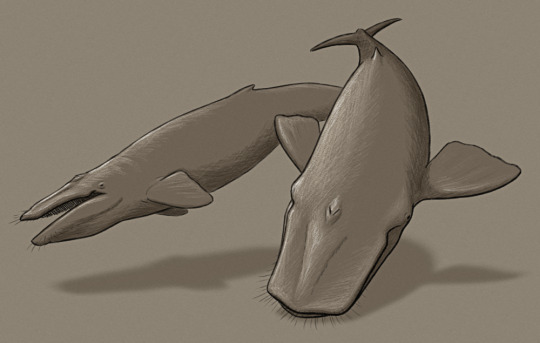
Rostrorutellum admantusi is descended from small cetotheres that became isolated in a large inland body of water (similar to the modern Caspian Sea), eventually becoming landlocked and gradually reducing in salinity towards fully freshwater.
Highly dwarfed in size, just 2-3m long (~6'6"-9'10"), they're slow swimmers with broad duck-like snouts that are used to scoop up mouthfuls of sediment and strain out their invertebrate prey in a similar feeding style to gray whales.
Due to the murkiness of the water, and the lack of large predators in their environment, they have poor eyesight and instead use sensory bristles and electroreceptors around their snouts to navigate and detect prey.
———
And an anonymous submission requested a "whale-like filter-feeding marine crocodile":

Sestrosuchus aigialus is a 6m long (~20') crocodilian closely related to the modern American crocodile, living in warm shallow coastal waters.
It's adapted for an almost fully aquatic lifestyle convergently similar to the ancient thalattosuchians, swimming with undulations of its long tail and steering with flipper-like limbs. But unlike other crocs it's specialized for filter-feeding, with numerous delicate needle-like teeth in its jaws that interlock to sieve out small fish and planktonic invertebrates from the water.
———
A couple more suggestions also asked for "fully aquatic pinnipeds" and "future crabeater seal evolution":

Euphausiolethrus volucer is a fully aquatic descendant of the crabeater seal. About 5m long (~16'4"), it occupies the ecological niche of a small baleen whale in the krill-abundant Antarctic waters that lack most actual baleen whales.
Its jaws contain numerous finely-lobed teeth that are used to strain krill from the water, and it utilizes all four of its wing-like flippers to swim in an "underwater flight" motion similar to that of plesiosaurs.
Highly social, it tends to congregate in pods that cooperate to herd swarms of krill for easier feeding.
#spectember#spectober#spectember 2023#speculative evolution#whale#cetacean#seal#pinniped#mammal#crocodile#pseudosuchia#archosaur#art#science illustration
263 notes
·
View notes
Text

Another #paleostream sketch
Siderops, a large Jurassic temnospondyl, ambushing a juvenile freshwater plesiosaur. Australia was a nice place :3
#paleoart#sciart#amphibian#animals#plesiosaur#marine reptile#australia#temnospondyl#siderops#paleostream#palaeoblr
500 notes
·
View notes
Note
Cynthia: Loch means lake! The Loch Ness Monster is a freshwater beastie! You just caught a plesiosaur, man!
-🦋🌕
.
#mod 🛣️#plural quotes#system sillies#plural memes#system memes#plural stuff#endo safe#pro endo#pluralgang#plural gang#endo friendly#plural system#🦋🌕 quote
11 notes
·
View notes
Text
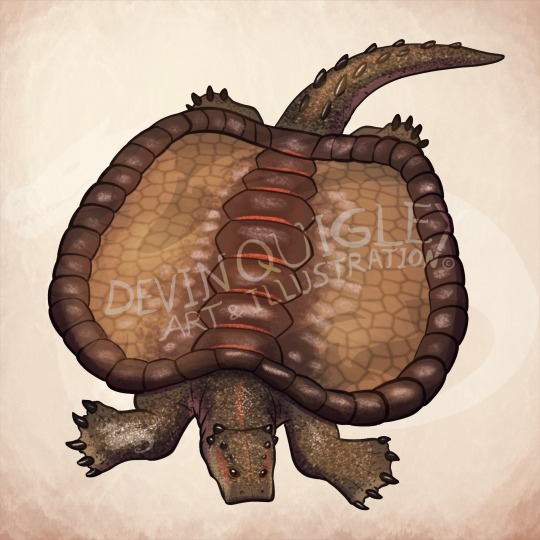
Paleovember 2023, Henodus!
You may look at this turtle-looking creature, with it's carapace and plastron, as well as it's aquatic habitat, and think to yourself, "hey, what a funky looking turtle!" Turns out, it's NOT a turtle. Not even close. Henodus is a member of a group of Triassic reptiles called placodonts that were relatives of plesiosaurs; turtles wouldn't evolve until much later. Henodus itself lived about 227 mya in Germany, and is unique among placodonts for living in freshwater habitats without coming onto land, and scraping vegetation off rocks.
#Henodus#placodont#triassic#germany#convergent evolution#turtle#prehistoric#paleoart#paleontology#paleoillustration#animal art#Paleovember#illustration#art#artwork#cartoon#drawing#procreate#artist on tumblr
25 notes
·
View notes
Text
Ada Shorewalker
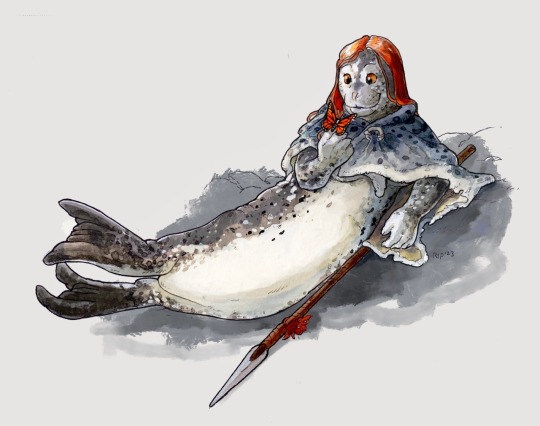
Image © @iguanodont
[Another OC, and one of the first ones I came up with before realizing that I could make an entire Monster Girl Summer out of it. Ada is definitely a version of myself, much like Jade Seven is. I tied her to Castle Xyntillian in this flavor text because it seemed like a good fit for for her, either as a powerful ally for lower level players, or as someone in need of rescue for higher level ones.]
Ada Shorewalker CR 8 N Monstrous Humanoid This anthropomorphic seal has long red hair and a gentle, curious expression. She wears a seal-skin cape and carries a spear.
Ada Shorewalker was always more interested in observation than in the actual hunt. While other selkies of her pack preferred to play malicious tricks on humanoids, Ada spent her time in tide pools and beach-combing, paying special attention to those land organisms that came to rest or forage on the seaside. As Ada grew up, she practiced her shapeshifting to emulate the other animals around her, and eventually grew in tune with nature to the point of learning druidic magic. She has now left her pack behind, exploring on land in order to learn more about the life that exists independently of the ocean.
Despite her gentle nature, Ada is especially interested in things like predator-prey relationships, decomposition and toxicology. Fungi are fairly rare in the ocean, and so she is fascinated by fungi and fungal creatures. When she is comfortable with someone, she often infodumps to them about all of the things she’s learned; her idea of “fun facts” is decidedly morbid and sometimes very gross. She views undeath as an aberration, but a particularly interesting one.
In combat, Ada switches from fun-loving to all business. She uses her animal focus to take on aspects like dolphin, orca or turtle, and then closes into melee with her spear or natural weapons. She prefers not to fight in wild shape mode, as Ada usually saves it to take a flying form if she needs to make a quick getaway. Ada is a little headstrong, and is not used to working alongside others, but given time and practice could become an excellent teammate.
Due to her attraction towards macabre topics, Ada Shorewalker has been considering an expedition to Castle Xyntillian. She has heard that Lake Xyntillian is home to an entire population of freshwater plesiosaurs, for example, and unusual plants and fungi grow throughout the grounds. She is confident that she can deal with any undead creatures that she encounters, because she has underestimated the sheer number of powerful undead that live on the grounds. She has no idea, for example, about powerful guests such as The Sickness or Debbie Twice-Born, or that Hubert Malevol the Huntsman has never stalked a selkie before and would be happy to add her head to his trophy collection.
Ada has red hair and a fat build in all of her humanoid forms. She gets along especially well with gnomes.
Ada Shorewalker CR 8 XP 4,800 Female selkie druid 6 (variant feral shifter) N Medium monstrous humanoid (shapechanger) Init +8; Senses darkvision 60 ft., Perception +14, scent Defense AC 19, touch 14, flat-footed 15 (+4 Dex, +5 natural) hp 90 (12d8+36) Fort +11, Ref +12, Will +14; +4 vs. fey Resist cold 10 Defensive Abilities resist nature’s lure Offense Speed 20 ft., swim 50 ft. Melee masterwork spear +15 (1d8+6/x3), bite +9 (1d8+4) or bite +14 (1d8+6), 2 claws +14 (1d6+4) Ranged masterwork spear +15 (1d8+4/x3) or sling +14 (1d4+4) Special Attacks animal focus (6 minutes/day), aquatic focus, powerful blows (bite), shake, wild shape (2/day, Tiny to Large animal, Small elemental) Spells CL 6th, concentration +10 (+14 casting defensively) 3rd—greater magic fang, neutralize poison (DC 16), speak with plants 2nd—barkskin, bear’s endurance, elemental speech, slipstream 1st—faerie fire, obscuring mist, produce flame, speak with animals 0th—detect magic, detect poison, purify food and drink, stabilize Statistics Str 18, Dex 18, Con 17, Int 16, Wis17, Cha 16 Base Atk +10; CMB +14; CMD 28 Feats Alertness, Combat Casting,Improved Critical (bite)B, Improved Initiative, Natural Spell, Power Attack, Skill Focus (Knowledge: nature) Skills Bluff +9, Diplomacy +9, Disguise +9, Knowledge (arcana, dungeoneering) +9, Knowledge (geography) +12, Knowledge (nature) +17, Heal +12, Perception +14, Sense Motive +14, Spellcraft +12, Stealth +13, Survival +14, Swim +21 Languages Aquan, Common, Druidic, Gnome, Sylvan SQ change shape (any Small or Medium humanoid, alter self), echo of reason, hold breath, nature sense, trackless step, wild empathy +9, woodland step Gear seafoam shawl of resistance +1, pearl of power (1st level), wand of cure light wounds, scroll of lesser restoration, masterwork spear, sling with 10 bullets,coral and pearls worth 46 gp Special Abilities Animal Focus (Su): At 1st level, as a swift action, a feral shifter can take on the aspect of an animal, gaining a bonus or special ability based on the type of animal emulated. This functions as the hunter’s animal focus class feature. The feral shifter can use this ability for a number of minutes per day equal to her druid level. This duration does not need to be consecutive, but it must be spent in 1-minute increments. She can emulate only one animal at a time. This ability replaces nature bond. Aquatic Focus (Su) Ada Shorewalker draws her animal focuses from the list for the aquatic beastmaster hunter archetype. Echo of Reason (Su) A selkie can instinctively alter the intonation of its voice to make anything it says sound more pleasing to those who understand it. When using the Bluff skill, a selkie treats its lies as one step more believable for the purposes of bonuses or penalties on the check. Shake (Ex) On a successful critical hit with its bite attack, a selkie automatically violently shakes a Large or smaller target. The target must succeed at a DC 16 Fortitude save or it is dazed for 1 round. Even on a successful save, the target still takes a –2 penalty on all attack rolls and skill checks for the next 2 rounds. The save DC is Constitution-based.
#ada shorewalker#original art#oc#monster npc#monster girl summer#age of monsters#castle xyntillian#pathfinder 1e#selkie#my inspiration was if ariel from the disney little mermaid was a biologist instead of an archeologist#also if she could fucking tear your throat out#the art references were for leopard seals specifically
63 notes
·
View notes
Text
Spectember D25: Ontogenetic niche shifts

Earth has recovered from a mass extinction just about 30 million years ago which would correspond to the time of the Oligocene, this version of earth happened the mass extinction of the K/Pg was delayed, so instead of ending in 66 million years ago cretaceous continued for other 30 million years until the asteroid struck down, ending the Mesozoic and so starting a new period of history of life, the delay of this mass extinction changed some aspects of evolutionary development of many groups, mammals did not became the only dominant clade in this time, many reptiles survivors have also took over, and with the short span of time that has passed to our modern times, the fauna amalgamation is a sort of reminiscence of the Eocene and even the Triassic, but cooler as the planet faced the glacial ages up to the Pleistocene.
In the ocean marine mammals are a thing of course, but they aren’t alone, Choristodere and crocodiles are also common if not predominant in the coasts and freshwater regions by a large amount, choristoderes in fact are coming in a path convergent to sauropterygians now resembling those to a big degree, with varied short body and long necked forms, predatory forms similarly to nothosaurs and very long finned forms that move across the open ocean, they have been very versatile to deal with the subsequent cooling of earth of the last 20 million years, and remain at top even with the new wave of mammals to take over the temperate and cold regions.
Among these, there are the largest coastal predators of the north hemisphere, a fully aquatic species that would look like an imitation of the Mesozoic pliosaurs, along them there are gracile fish eater forms that looks more kind to a plesiosaur, their jaws are narrower and their necks and flippers are longer, but this is no more like the juvenile of this same giant.
The Mocker Retroleviathan is a descendant of smaller choristoderes that ventured into the oceans million years before the mass extinction that already established through the extended later cretaceous thanks to the minor extinction events caused by the ecological transitions of those million years, and after the cataclysm the empty ocean left behind by the large reptiles were early claimed by these reptiles in a short time, becoming megafauna and spreading across the oceans.
The Retroleviathan is the most formidable of these, reaching up to 7 meters and weighting 2 tons, it normally feeds on different large animals including other large choristoderes, some of the piscivorous pelagic crocodilians and the increasingly large para-cetos which are derived multies that adopted fully an aquatic lifestyle resembling an archeocete with a sirenian head but with unique dentitions. They are viviparous, a female can gestate more than 10 offspring which at birth are quite independent of their parents, only being sheltered in the nearby of the territory of the adults until they reach maturity.
27 notes
·
View notes
Note
“unfortunately plesiosaurs, which were oceanic, almost certainly could not thrive in a cold lake in Scotland”
I know you didn’t say this, but while the temperature and size of the lake matter, its very possible the salinity doesn’t matter that much for aquatic reptiles except for buoyancy. I know from research (listen, i had a dream that made me curious) that sea turtles can do just fine in freshwater and they actually use freshwater to help dehydrated ones in rehab.
We cant be 100% sure how the late oceanic reptiles handled salt, but it wouldn’t be surprising if they handled it much the same by being good at excreting the excess.
I’m rather certain tumblr user transcyberism did indeed mostly mean the size and temperature of a lake compared to the open ocean! Loch Ness is pretty big, the biggest freshwater loch of Great Britain by volume, in fact, but you know, it would not compare to conditions of the sea in many ways. But, what I’m really focused on here is, I wouldn’t say sea turtles do just fine in freshwater? I hate to argue so firmly but a few sources indicate that sea turtles, while they can survive in freshwater for a while, suffer through quite a few bad side effects due to them being adapted to saltwater specifically and can even die prematurely due to long term exposure. Some sea turtles can survive in freshwater for years, sure… but I would call it just that, survival. Stress, a weakened immune system and even organ failure isn’t particularly nice! Using freshwater to rehydrate them seems logical, but it’s not a long term living situation. I don’t know if that’s the case for other marine reptiles, but it seems to be the case for sea turtles.
That being said, I agree on your last point! Extinct marine reptiles most likely would also have mechanisms to expel excess salt, yes.
#also im a tad confused on why send me this when i did not even make the original point? /nm#oh well. apologies anon!#asks#anonymous asks#anon#anonymous#aquatic
17 notes
·
View notes
Text
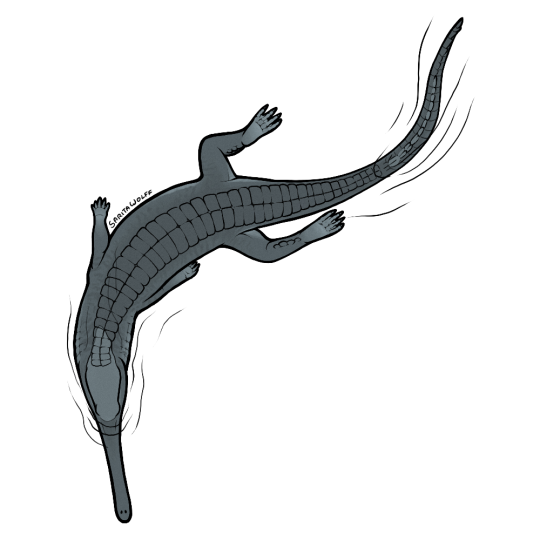
#Archovember Day 11 - Macrospondylus bollensis
The Thalattosuchians were a clade of marine pseudosuchians commonly called “marine crocodiles” or “sea crocodiles”. They were seperated into two groups, the Teleosauroids and the Metriorhynchoids. The metriorhynchoids seemed to be adapted for spending all their time in the water: they had smooth, scale-less skin, tail flukes, and even flippers. Meanwhile, teleosauroids held onto their crocodyliform nature, retaining their osteoderms and probably heading onto land when needed. They inhabited a wide range of habitats: from semi-marine coasts and estuaries, to open-ocean, to freshwater. The Early Jurassic Macrospondylus bollensis was one of these teleosauroids.
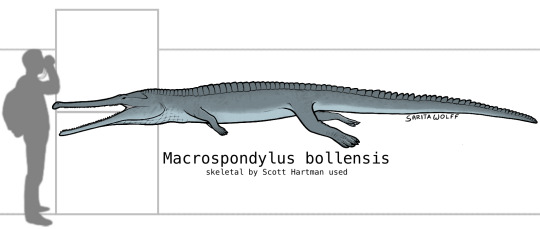
Macrospondylus bollensis, long known as “Steneosaurus bollensis” (Steneosaurus being a wastebasket taxon for thalattosuchians) finally had its genus revived in 2020. At 5.5 m (18 ft), it was the largest known Early Jurassic crocodylomorph. Like many other teleosauroids, it had a long, tapering snout, similar to its modern equivalents the gavialids. This snout would have allowed it to quickly maneuver through the water with little resistance, snapping up fish. Oddly enough, like Megalosaurus, Macrospondylus is also represented in the Crystal Palace gardens (though they are simply labeled as Teleosaurus). Modeled after gharials and based on much better preserved fossils than Megalosaurus, the teleosaur statues actually hold up pretty well, other than using a more crocodilian scute pattern.
Macrospondylus bollensis fossils have been found in Germany, the UK, and Luxembourg. It lived in the newly forming Tethys Sea, which was warm and shallow at the time, dotted with small tropical islands where Macrospondylus would have likely emerged to bask in the sun. This area is known for its fossilized crinoids, cephalopods, bivalves, crustaceans, ichthyosaurs, sharks, bony fish, and more, often exquisitely preserved “frozen in time” due to sudden events and nigh perfect fossilization factors. There was an abundance of fish here for Macrospondylus to feast upon, including chimaeras like Acanthorhina, the armoured Dapedium, the long-bodied Euthynotus, pups of the shark-like Hybodus, the herring-like Leptolepis, and many more. It would have lived alongside a variety of icthyosaurs, small plesiosaurs, other teleosauroids such as Mystriosaurus, Pelagosaurus, and Platysuchus, pterosaurs such as Campylognathoides and Dorygnathus, and come across sauropods such as Ohmdenosaurus wandering the shorelines. But Macrospondylus was not the biggest “fish” in the sea, and if it ventured into the open ocean it could have come across the 8–10 metre (26–33 ft) long icthyosaur Temnodontosaurus, the apex predator of the Early Jurassic Tethys Sea (which is also on display at the Crystal Palace!)
#my art#SaritaDrawsPalaeo#Macrospondylus#Macrospondylus bollensis#Teleosauroid#Teleosaur#Thalattosuchians#Crocodyliforms#pseudosuchians#archosaurs#archosauromorphs#reptiles#Archovember#Archovember2023
10 notes
·
View notes
Text
Facts of the Day: 🦖Mosasaur🦖

Name Meaning: Lizard of the Meuse River
Age: Cretaceous
Size: The largest species of Mosasaur (the Tylosaurus) would have grown to be up to 50 feet long, most were over 10 feet long at least
Distribution: Nearly worldwide, with even a freshwater mosasaur being found in Hungary.
Diet: Anything, with stomach contents showing ammonites, bony fish, sea turtles, plesiosaurs, and even sea birds
Summary: Mosasaurs were quite the formidable lizard of the ocean. Their biology was designed to have them be sleek, streamlined and fast to hunt their prey. While Mosasaurs are not dinosaurs, they are reptiles, closely related to modern day snakes and monitor lizards. They even had the capabilities to expand their jaws like snakes to help with swallowing large whole prey. While Mosasaurs were aquatic, they were also reptiles and not fish, which means they often had to resurface for air, similar to the sea turtles around at the time.

#baby shark bites!#I was really tempted to do a Jurassic World gif#but for the sake of scientific accuracy#you get the skeleton instead#I just really love Jurassic World okay???#Age Regression#Agere#age regressor#petre#pet regression#pet regressor#sfw age regression#sfw regression#sfw agere#sfw age regressor#sfw petre#sfw pet regression#sfw pet regressor
13 notes
·
View notes
Text
Freshwater Hesperornitheans
Brodavis by Scott Reid, a taxon that occurs in freshwater environments.
Hesperornithes are some of the most iconic extinct birds. Or rather, the larger, marine members of this group like Hesperornis or Canadaga are; little discussion is there to be made of the myriad membrs of this group that not only were smaller, but lived in freshwater.
Typically, when such animals are brought up, they’re considered “primitive” members of the group, still capable of flight. But not only did the invasion of freshwater habitats began late in the evolution of these birds, they were equally as flightless as their marine cousins. This is quite extraordinary, a group of marine flightless seabirds having invaded freshwater biomes, some as far inland as Mongolia!
Now, the invasion of freshwater bodies by marine tetrapods is not new. Freshwater seals, dolphins and manatees co-exist with us today, and in the past various lineages of plesiosaurs invaded freshwater. Likewise, flightless diving birds occur in freshwater, in the form of some highly endangered grebes. But flightless seabirds invaded deep into continental waterways is unprecedented, occuring in ecosystems not only dominated by terrestrial (and freshwater) predators but also far inland. Most freshwater diving birds today are of the flying variety, not only to evade predators but to cover distances as freshwater environments are seldomly permanent.
Seeing as hesperornitheans were functionally similar to cormorants and ducks it makes one wonder if cormorants would have gone flightless in a world without predatory mammals. Again, these birds rely on flight for migration and seeking new territories, something these freshwater hesperornitheans didn’t have access to, but were successful enough to expand far and wide.
More studies should be conducted on their biology, as these freshwater birds are quite unlike any aquatic tetrapods alive today.
6 notes
·
View notes
Text


Opalised fossils from Lightning Ridge, N.S.W, Australia. From the collection of the Australian Opal Center. Clockwise from top left: freshwater snail; plesiosaur tooth; crocodile tooth; pine cone; pelvis bone of ornithopod dinosaur.
5 notes
·
View notes
Text
I’ve seen some of these stories! They’re cool and it’s fun to imagine some unknown plesiosaur-looking creature that can somehow slip in and out of Loch Ness, but ask any serious biologist and they’ll tell you it’s an absurd one-in-ten-trillion chance that the various sightings are a reptile from the Cretaceous.
BUT!! Once you accept that the popular image is almost certainly wrong, you can appreciate that Loch Ness has some very interesting features and phenomena, and there ARE some documented things that we can’t explain! (One sonar study identified some large unidentified objects at depth that later disappeared! Explanations range from schools of salmon behaving strangely to Greenland sharks wandering into freshwater!)
Just because Hollywood and popular culture got it wrong, doesn’t mean that scientists studying the loch are scammers or unfairly taking advantage of people! There’s a lot of very legitimate science to do and it’s exciting stuff!

There are many benefits to being a marine biologist
162K notes
·
View notes
Text
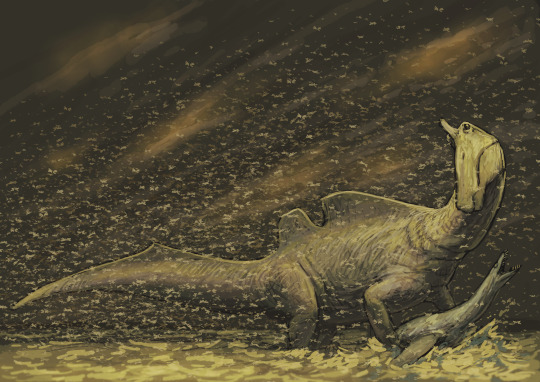
Another sketch from the #paleostream
Ichthyovenator catching a freshwater plesiosaur while millions of mayflys swarm
485 notes
·
View notes
Note
I really hope multiple submissions are allowed in one ask lol
Super Mario: Birdetta, Plessie, Yoshi Kid (TTYD)
Jurassic Park: the Big One (JP1), Roberta/Rexy (JP1), sick Triceratops (JP1), Buck and Doe T. rex (TLW), alpha female raptor (JP3), Spinosaurus (JP3), Toro (JW:CC), Chaos Limbo and Grim (JW:CC)
Monster Hunter: Deviljho
Prehistoric Planet: Hank/T. rex dad (Coasts), female Velociraptor (Freshwater), Deinocheirus (Freshwater)
Land Before Time: Sharptooth, Chomper, Ozzy and Strut
Pokemon: Archeops (assuming Archaeopteryx is basal enough to not be disqualified for birdiness)
King Kong (2005): Vastatosaurus rex, Venatosaurus
Valley of Gwangi: Gwangi
Godzilla: Gorosaurus
Ice Age: Momma Dino, Rudy
They weren't originally, but I guess since I have no way to really enforce this on anon I will allow this ask and adjust the rules a little!
Anyway:
Birdetta is ADDED!
Plessie, I'm not so sure about, but I'm leaning towards NOT adding it; it's based off of a few different reptiles, none of which are dinosaurs, but the reptiles it is based off of are marine ones, while it seems to be terrestrial? I think since the intent was for it to be a plesiosaur or similar I won't count it for now, but will think about it.
Everything else is ADDED, but keep in mind:
There's a lot of overlap in these, so it's likely a couple (namely the Jurassic Park ones) may not make the final cut
For simplicity's sake, I will lump in related characters in one ticket, such as the T Rex parents, Ozzy and Strut, etc, since their purpose as characters only exist as a group.
Thanks for the submissions! Please do not make anymore today!
0 notes